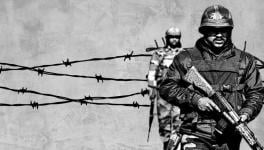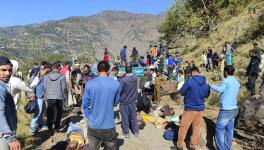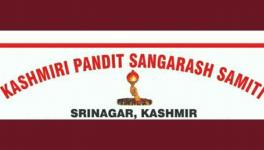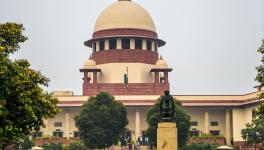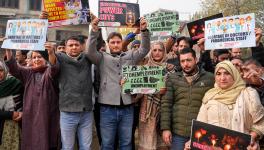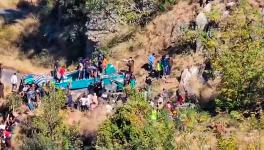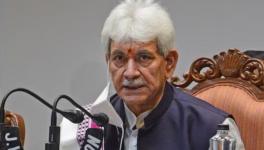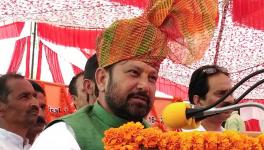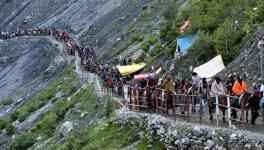An Overview of the ‘Annual Human Rights Review 2017’ by the JKCCS
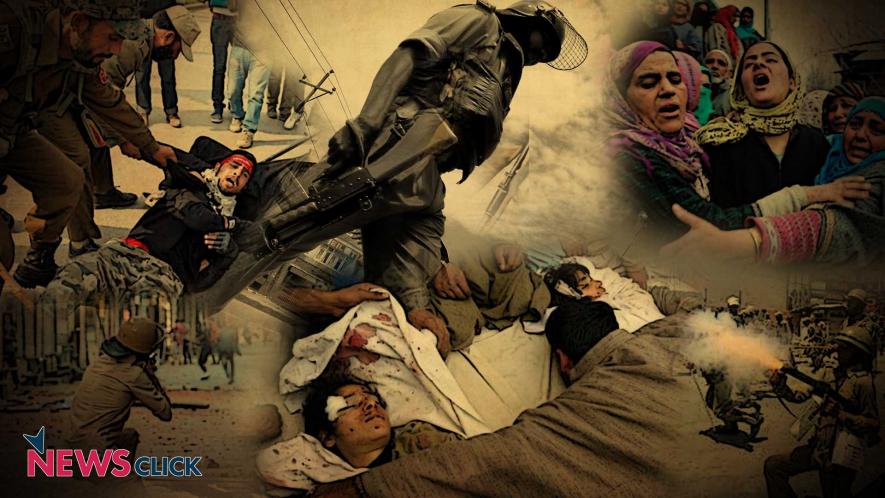
Newsclick Image by Sumit Kumar
The Jammu and Kashmir Coalition of Civil Society has come out with its annual report on Human Rights in Kashmir. The report consists of 23 parts, of which the first part is an overview of the report and the last chapter is on suicides and fratricides in the armed forces.
In 2017, there were 450 killings in Kashmir. Out of these killings, 124 were from the armed forces, 217 were militants, 108 were civilians, and one Ikhwani (pro-government militant) were killed. Of the 217 militants killed, 84 were local, 28 were foreigners, and 104 could not be identified. Almost half of the killings took place within the four months between May and August. The district which saw the highest civilian killings was Pulwama, and Ganderbal. Bandipora saw the least.
Regarding violence against women, the report divided it into two parts, one was on killing, and the other was on braid chopping. In 2017, 20 civilian women were killed of which eight died when suspected militants attacked a bus that had Amarnath Yatris. Five women were killed near encounter sites, four died in the shelling across the LOC, one girl died from a grenade blast in Tral town, and one woman was killed by unidentified gunmen in Seer village of Tral in Pulwama. There were 150 incidents of braid chopping between September and October. The braid chopping resulted in many women refusing to go outdoors unless accompanied by a male family member. This had a severe impact on students, who preferred to stay at home rather than risk having their braids cut. The failure of the police to nab braid choppers led many in the public to view these incidents as a psychological operation by the intelligence agencies.
The state agencies still have not been able to trace or explain more than 8,000 ‘disappeared’ persons. This year there were seven disappearances, of which five bodies have been found bearing torture and bullet injuries, the remaining two are still untraced. The State Human Rights Commission (SHRC) has urged the government to investigate 2,080 unmarked and mass graves in Poonch and Rajouri districts. Yet the response is lacklustre at best.
On the topic of probes ordered by the government for various human rights abuses, there were four probes ordered by the government regarding the 2016 killings during the protests. The report views such probes as only a means to ‘manage’ situations from spiralling out of control.
2017 brought the use of civilians as ‘human shields’ in Jammu and Kashmir to the notice of the international community. The viral video of Farooq Ahmad Dar strapped to a jeep brought widespread condemnation from the international community. Yet despite the criticism of the act, Major Leetul Gogoi received a Commendation Card from the Chief of Army Staff. Other incidents also occurred when the Army coerced two Sumo drivers in separate incidents to transport their personnel. One of the drivers was killed when militants opened fire on the vehicle.
Torture continues to be used as a psychological weapon in Jammu and Kashmir. The report stated that most people prefer not to report their torture, yet five incidents were mentioned in the report. Some of the victims have died due to complications like kidney failure arising out of the torture. One of the incidents of torture occurred in Tihar Jail when 18 inmates were tortured by the Tamil Nadu Special Force.
The use of ‘pellet’ shotguns as a riot control measure has still not abated in Jammu and Kashmir. The ‘pellet’ shotguns, as referred to by various quarters, are actually 12-gauge pump-action shotguns loaded with birdshot (a pellet size used for hunting birds). The effective range for birdshot is around 40 yards or 36.576 metres, this range will kill a bird or small animal. In 2017, there were reportedly 41 persons who received eye injuries due to ‘pellet’ guns. 6 had injuries in both eyes, and 35 were injured in one eye. Two students are in a critical condition after being fired upon by these guns in two separate incidents. Four people have died due to the use of ‘pellet’ guns.
The topic of arrests and detention were covered under two headings; arrests under administrative detention, and arrests by the National Investigation Agency (NIA). Under the heading of administrative detention, the report observed that the Public Security Act (PSA) has been used to keep people out of circulation. The report also mentioned the Chief Minister’s statement that 1,059 dossiers have been prepared by the police over the last three years. Some of the detainees include wheelchair-bound people, elderly persons, as well as journalists and political leaders. The arrests by the NIA include Hurriyat leaders, trade-body leaders, the head of the Kashmir Bar Association, a Kashmir University scholar, and a photojournalist.
Over 2017, there have been 18 incidents, including one conviction, wherein Kashmiris have been targeted outside the state. These include attacks on students, threats and ultimatums for Kashmiris to leave, as well as an incident where a hospital refused treatment to a woman suffering from a neurological condition.
There were eight incidents where journalists and the media faced threats, intimidation and violence from State authorities. This year a French journalist joined the fraternity of imperilled Kashmiri journalists when he was arrested by the police for allegedly violating his visa. He has since been released on bail. The state government has also banned 34 TV channels. Apart from news and religious channels, the government banned one sports channel, two culinary channels, and a music channel in Kashmir.
Internet in 2017 continued to be suspended whenever an incident involving the deaths of civilians, encounters with the police, and other spikes in violence occurred. Mobile networks and internet connectivity were suspended 37 times in 2017.
The state government restricted the people of Jammu and Kashmir from observing Eid-ul-Fitr Muharram in 2017. There were also 20 state-wide and 40 partial or district-wide curfew-like restrictions. Around 22 complete shut-downs and 100 partial or district-wide shut-downs were observed.
There were 12 incidents when the property of civilians had been vandalised by the security forces. This included ransacking and breaking window panes of houses, as well as damaging private vehicles. Nine political workers and activists suspected to be pro-India have been killed by militants in 2017. Three belonged to the PDP, two were former PDP, two from the National Conference, one was from the BJP, and one was from the Janata Dal United. The families of militants and policemen continue to face attacks and harassment from the armed forces and militants respectively.
Considering the number of human rights violations that have occurred in 2017, the report referred to the SHRC as a ‘toothless tiger’. Its impotence as an institution is stark given that it has been completely ignored by the state government on several occasions for recommending compensation to victims of human rights abuse. 2017 saw nine suicides and one fratricidal killing in the armed forces in Jammu and Kashmir.
Get the latest reports & analysis with people's perspective on Protests, movements & deep analytical videos, discussions of the current affairs in your Telegram app. Subscribe to NewsClick's Telegram channel & get Real-Time updates on stories, as they get published on our website.









